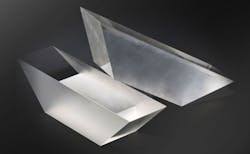A Dove Prism is an optical prism that can be used to rotate, retroflect, or invert an image. It is shaped like a triangular right-angle prism with the top cut off, or truncated.
These prisms work best with collimated light. The length of these prisms (approximately four times the height) means they will introduce substantial astigmatism when they are used with converging light.
If light enters through a sloped face and is propagated along the longitudinal axis of the prism it reflects once from the bottom face and emerges from the other short side, resulting in an inverted image. There is one interesting and unique feature of dove prisms: If you rotate the prism around the longitudinal axis the image will rotate at twice the speed. Rotate the prism 30 degrees, and your image will rotate by 60.
This special property of dove prisms means they can rotate a beam of light by an arbitrary angle. While images passing through the prism are flipped, they are not laterally transposed or deviated because only one reflection takes place.
Even if the propagation axis and the prism’s longitudinal axis are not perfectly parallel, the high incidence angle means that the light reflecting from the bottom face undergoes total internal reflection. For situations where the hypotenuse can’t be kept clean enough for TIR, we can provide metal or hydroelectric coatings.
Factory Standard
Contact us for manufacturing limit or custom specifications.
Specifications for Dove Prisms
The longest bottom face of the prisms typically feature an unbeveled sharp edge, while the top surface is ground. Our dove prisms are manufactured from high quality BK7 Grade A optical glass, Corning Fused Silica 7980, JGS1 UV grade fused silica, and JGS2.
The dimension tolerance of a prism is defined as the acceptable variation of ranges in dimension. Our factory standard is a dimension tolerance of +/- 0.1 mm, and we can provide tighter tolerances if requested.
The angle tolerance of our prisms is typically less than 5 arc minutes. This is defined as the amount of allowable variations in angles.
Flatness of a prism is defined as the deviation of each of the surfaces from an ideal flat surface. The factory standard for our dove prisms is l/4l at 632.8 nm.
Our factory standard for surface quality is 60-40 scratch and dig, which guarantees a highly polished surface. A scratch is defined as any marking or tearing of the glass surface. Digs are small rough spots on the glass surface, similar to pits. Bubbles in glass are considered digs.
A surface quality rating of 60/40 scratch dig means that there are no digs with a diameter of larger than 0.04 mm or 0.0016 inch, and that all scratches have a brightness level of of less than 60 and, laid end to end, are no longer than ¼ the diameter of a circle with an area equal to the surface area.
Dove prisms have applications in fields such as astronomy, interferometry, and pattern recognition. They are used as image rotators for a variety of opto-mechanical systems. This type of prism was invented by Heinrich Wilhelm Dove, (1803-1878), a Prussian meteorologist and physicist.
